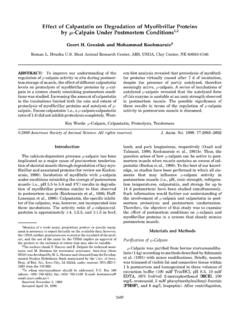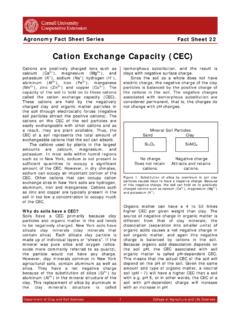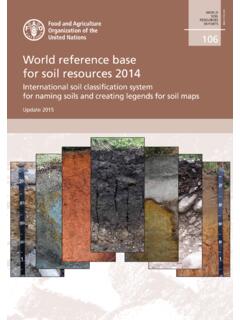Transcription of CENTER PIVOT IRRIGATION - Agricultural Research Service
1 1 Supervisory Agricultural Engineer and Research Leader, Agricultural Systems Research Unit, NorthernPlains Agricultural Research Laboratory, USDA- Agricultural Research Service , 1500 North Central Ave., Sidney,MT 59270. E-mail: CENTER PIVOT IRRIGATIONR obert G. Evans1 INTRODUCTIONThe first Self-Propelled Sprinkling Irrigating Apparatus was invented in 1948 and patented in 1952 by FrankZybach in eastern Colorado. The early systems were the foundation of the development of modern self-propelledcenter PIVOT and linear move IRRIGATION systems. These very adaptable water application methods have experiencedtremendous growth around the world in recent years due to: 1) their potential for highly efficient and uniform waterapplications; 2) their high degree of automation requiring less labor than most other IRRIGATION methods; 3) large arealcoverage; and 4) their ability to economically apply water and water soluble nutrients over a wide range of soil, cropand topographic conditions.
2 Most of the following discussion is directed towards CENTER PIVOT machines althoughmuch will also apply to lateral move one third of all IRRIGATION , or about 60% of all sprinkler irrigated lands (about 125,000 machines onapproximately million acres [ million ha]) or about 29% of the total irrigated area, in the USA utilizes self-propelled IRRIGATION systems, mostly CENTER pivots (CP). These sprinkler IRRIGATION systems have allowedagricultural development marginal lands unsuitable for surface IRRIGATION ranging from light sandy soils and heavyclays with large variations in topography and soil types within the same field. For these reasons, CENTER pivotirrigation in the USA has increased by more than 50% from 1986 to standard 125 ac (~50 ha) CENTER PIVOT system will cost US$35,000 to US$45,000 excluding land and water supplydevelopment costs. Water development costs depend on the source of water and power ( , electric, diesel ornatural gas).
3 Generally, the largest annual costs for these machines are for power or fuel to pump of the semi-automatic operation of CENTER pivots and lateral moves, it is relatively easy to carefully managesoil water levels. Almost all crops including sugar cane, orchard and vines as well as more traditional field cropssuch as maize, potatoes, small grains, alfalfa, and vegetable crops can and have been successfully irrigated withcenter PIVOT water application systems under a wide range of conditions. Some CENTER PIVOT irrigated crops requirespecial cultural practices such as planting in circles or the use of small pits or reservoirs in the furrows to facilitateinfiltration on heavy soils and prevent surface runoff. Application efficiencies can range as high as 80% or moredepending on management and a properly designed installation for the this presentation, I will discuss the general characteristics of self-propelled CENTER PIVOT and lateral move irrigationsystems, their management and general design concerns.
4 I will finish with a discussion of the future directions for CENTER PIVOT IRRIGATION including the potential for precision (site specific) IRRIGATION and chemigation CHARACTERISTICST here are considerable variations in construction of these large machines between the different manufacturers. However, a CENTER PIVOT or lateral move basically consists of pipeline (lateral) mounted on motorized structures(towers) with wheels for locomotion. A CENTER PIVOT machine rotates around a PIVOT point in the CENTER of the fieldwhereas a lateral move machine travels along a straight path and has a separate guidance system. Sprinkler outlets are installed on the top a pipe supported by steel trusses between adjacent tower structures. The towers are usually90 to 200 ft (30 to 60 m) apart and each tower has a 1 hp motor and sits on two large rubber or steel tires. Thecombination of pipe, truss and sprinklers between two towers is called a span.
5 Flexible couplers at each towerconnect the pipes of two adjacent spans. The maximum length of span is a function of pipe size, pipe thickness(strength), field slope and topography. Span length does not have to be uniform; in fact, it is often varied to matchCenter PIVOT IRRIGATION (Draft July 2001) Page 2field dimensions or to provide adequate clearance between the truss and soil surface on rolling terrain. An overhang is a smaller pipe with sprinklers that is often suspended by cables beyond the outermost tower(s) toincrease the wetted area. Large volume end guns and corner systems may also be added to the end of a machine toincrease the wetted area in the corners or to cover additional areas. Machines can be more than 4900 feet (1000 m)long although the most common length of a basic machine is about 1300 ft (~400 m). The distance between thetrusses and the ground can range from 4 to 14 ft ( to m) with most between 8 and 9 ft ( and m).
6 Basicsystem life should be 15 to 20 years not including sprinkler heads, pumps and other ancillary machines are powered by electricity, although some manufacturers use hydraulic motors which are moreexpensive. A one constant speed horsepower electric or hydraulic drive motor is used to propel each tower. Towermotors should always be covered to extend their useful life. Electric power wires and/or hydraulic lines run thelength of the machine with control boxes or valves at each tower. A primary control panel is usually located at thepivot base or at the engine on lateral moves. Hydraulic powered systems have a higher initial cost but may havelower annual costs because of lower maintenance and operational costs. Various manufacturers are looking atusing more expensive variable speed electric motors to reduce start-stop effects on uniformity, especially withchemigation including a PIVOT base structure, there can be one to fifteen or more towers on each system.
7 Towers are usuallyidentified by number starting with the tower closest to the PIVOT base or the linear move engine/pump assembly. Thetowers should always follow the same tracks through the field. Equipment crossings and problems with traction aswell as runoff from the compacted, wet wheel tracks are sometimes serious concerns. Keeping linear move and CENTER PIVOT machines in good alignment is critical to proper operation. Substantialdamage can occur to the equipment and the crops if the alignment system fails. Alignment sensors are located onthe pipeline at each tower causing the tower motor to start or stop . Alignment is controlled by electronic straingauges, radio or laser controlled sensor systems. Often the first tower (closest to primary controls) will have anadditional adjustable timer that will turn off the entire system if that tower does not move at least once every two tofive minutes for extra protection against alignment system failures.
8 Inadequate traction at a tower will often causealignment , the tower farthest from the PIVOT point controls the movement of the entire machine. Minimum rotationtimes (maximum speed) are commonly between 14 and 20 hours (2 to 3 m/min at the outer tower). Special highspeed gear boxes can be installed on each tower to reduce rotation times to less than 12 hours ( , m/min at theouter tower) which is often desirable on sandy or cracking clay soils. Timing controls at the control paneldetermine the relative average speed of the outer tower. The on-off cycle time of the outer control tower is usuallyabout 1 minute ( , on a 50% speed setting, the outer motor is on 30 seconds in every minute.) A 100% settingcauses the machine to travel at maximum speed (minimum rotation time) whereas a 50% setting results in the outertower moving at half the maximum speed. Of course, the slower the rotation speed, the greater the amount of waterapplied.
9 All the other towers try to stay in alignment with the end tower as regulated by the alignment system. However, tower movement in the interior of the system is somewhat random and start and stop times of 1 to 3minutes may occur. Thus, because of the start-stop action the uniformity coefficients in the direction of travel arelargest near the PIVOT and the end tower and the smallest near the CENTER of the IRRIGATION all the towers on standard electric systems typically have the same motors and gearing ratios, the towers startand stop to stay in alignment. The start-stop action of the towers is not usually a problem with water applicationuniformity which is averaged over several days. However, with pesticides becoming more specific, applied in smallamounts and costing several dollars per gram, this jerky movement may present a concern if pesticides are to beapplied through the IRRIGATION water or if a separate system attached to the CENTER PIVOT trusses.
10 Costly variablespeed electric motors on each tower may be justified for pesticide systems where uniformity is critical. Hydraulicallypowered tower motors can be adjusted so that there is no start-stop movement and applications are more uniform. Flow requirements for CENTER pivots and lateral move systems are defined in terms of total flow supplied to thesystem or the total system capacity, QT (gpm), for hydraulic requirements, and gross system capacity, Qg (gpm/ac),for IRRIGATION requirements and management. Qg is defined as the total system capacity, QT, divided by the totalirrigated area. Standard inside diameters of CENTER PIVOT pipes are , , , , and inches (135 CENTER PIVOT IRRIGATION (Draft July 2001) Page 3mm, 146 mm, 162 mm, 197 mm, mm and mm, respectively) with most (50-52 hectare)125-130 acresystems using inch (162 mm) steel tubing with a wall thickness of inch ( mm).The two types of sprinklers used with CENTER PIVOT and linear move systems are impact and spray heads.
















